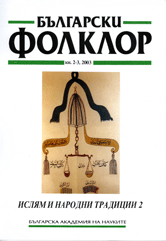Накшбендският шейх Сабри Хюсеин (Софта баба) и неговото тюрбе в Тутракан
Naqshbandi Shaykh Sabri Huseyin (Softa Baba) and His Türbe in Tutrakan
Author(s): Lubomir MikovSubject(s): Anthropology
Published by: Институт за етнология и фолклористика с Етнографски музей при БАН
Summary/Abstract: Sabri Huseyin is a naqshbandi shaykh, who lived probably from the end of the 18th to the middle of the 19th century. It is known by tradition that he came from Buhara. It is also told that he was a softa - first in Azerbaijan, and then in Istanbul. Because of that today he is known mainly by the byname of Softa Baba. The most of his life passes in northeastern Bulgaria. The text of the article also includes data about his descendants. During the first half of the 19-th century Sabri Hüseyin had been one of the most respected Naqshbandi shaykhs in Tutrakan and the region. A proof for that is his türbe - an octagonal stone building, erected about the middle of the same century. At the türbe there is also a semahane, which is octagonal too, but is built of bricks and beams, earlier that the türbe - probably in the second quarter of the 19-th century. Today the türbe of Sabri Hiiseyin and the semahane are in comparatively good condition and represent the only naqshbandi sacred bulidings in Bulgaria. They could be characterized as zaviye, which was the main center of Naqshbandiyya in southern Dobroudja from the middle of the 19-th to the middle of the 20-th century. After 1826 the naqshbandi community in Tutrakan and the region is strongly influenced by the Bektashis, who joined it as a result of persecution by Ottoman officials after their order was closed down. The naqshbandi community in Tutrakan is influenced also by the Kizilbashis, who even adopt the "zaviye" of Sabri Hiiseyin after the return of southern Dobrudja within the borders of Bulgaria on 7 Sept. 1940. Today the "zaviye" is visited mainly by Kizilbashis for the rituals connected to Ashura and the türbe itself is one of the emblematic buildings in Tutrakan.
Journal: Български фолклор
- Issue Year: XXIX/2003
- Issue No: 2-3
- Page Range: 28-44
- Page Count: 17
- Language: Bulgarian
- Content File-PDF

